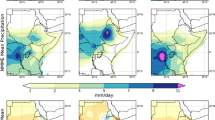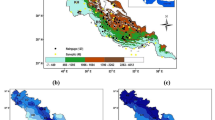Abstract
This study makes use of the WMO’s multimodel data set called THORPEX integrated grand global ensemble (TIGGE) towards the construction of multimodel superensemble forecasts covering a period of 10 days. The goal of this study is to explore the forecast skill for precipitation forecasts over the Greater Horn of Africa (this is a consortium of 11 countries). The multimodels include forecast data set from a suite of models that include: The European Centre for Medium Range Weather Forecasts (ECMWF), the National Centre for Environmental Prediction (NCEP), the Center for Weather Forecast and Climatic Studies (CPTEC) and the United Kingdom Meteorological Office (UKMO). After performing a training phase for the superensemble weights covering the previous 450 days of October, November and December months of 2008–2012, forecasts of precipitation were prepared for the multimodel superensemble. These covered day 1 to day 10 of forecasts over the region. Various skill metrics were prepared to validate the forecast rainfall against the tropical rainfall measuring mission (TRMM) observed rainfall data. This study shows that the construction of the multimodel superensemble was a worthwhile effort since it provided the best overall skills for the RMS errors, the spatial correlations and the equitable threat scores and their bias errors for precipitation forecasts from day 1 to day 10 over all of the countries covered by the Greater Horn of Africa. The best among the member model was the UKMO model. This study strongly suggests the usefulness of a product such as the multimodel superensemble for improved precipitation forecasts over East Africa.






Similar content being viewed by others
References
Anthes RA (1983) Regional models of the atmosphere in middle latitudes. Mon Wea Rev 111(6):1306–1335
Bhardwaj A, Krishnamurti TN, Sharma OP, Mishra AK, Singh T (2015) Monsoon precipitation forecast using a suite of mesoscale models. (under peer review by meteorological applications)
Donohoe A, Marshall J, Ferreira D, McGee D (2013) The relationship between ITCZ location and cross equatorial atmospheric heat transport; from the seasonal cycle to the last glacial maximum. J Clim 26:3597–3618
Downie C, Wilkinson P (1972) The geology of Kilimanjaro. University of Sheffield, Earth Sciences, Sheffield
Hastenrath S (2001) Variations of East African climate during the past two centuries. Clim Change 50:209–217
Hou A, Jackson GS, Kummerow C, Shepherd C (2008) Global precipitation measurement. In: Silas M (ed) Precipitation: advances in measurement, estimation, and prediction. Springer, Berlin, pp 1–39
Huffman GJ, Adler RF, Bolvin DT, Gu G, Nelkin EJ, Bowman KP, Hong Y, Stocker EF, Wolff DB (2007) The TRMM multi-satellite precipitation analysis: quasi-global, multi-year, combined-sensor precipitation estimates at fine scale. J. Hydrometeor 8:38–55
Huffman GJ, Adler RF, Bolvin DT, Nelkin EJ (2010) Chapter 1 in satellite rainfall applications for surface hydrology. In: Hossain F, Gebremichael M (eds) The TRMM multi-satellite precipitation analysis (TMPA). Springer, Berlin ISBN: 978-90-481-2914-0, 3-22
Kibara DG (2011) Predictability of weather on extended NWP timescales over Kenya using the NCEP GFS model. Msc. Thesis, Dept. of Meteorology, University of Nairobi
Krishnamurti TN, Kumar V (2012) Improved seasonal precipitation forecasts for the Asian monsoon using 16 atmosphere-ocean coupled models. Part II: anomaly. J Clim 25:65–88. doi:10.1175/2011JCLI4126.1
Krishnamurti TN, Kishtawal CM, LaRow TE, Bachiochi DR, Zhang Z, Williford CE, Gadgil S, Surendran S (1999) Improved weather and seasonal climate forecasts from multimodel superensemble. Science 285:1548–1550
Krishnamurti TN, Bachiochi D, LaRow T, Jha B, Tewari M, Chakraborty DR, Torres RJC, Oosterhof D (2000a) Coupled atmosphere-ocean modeling of El-Nino of 1997–98. J Clim 13:2428–2459
Krishnamurti TN, Kishtawal CM, Zhang Z, LaRow T, Bachiochi D, Williford E, Gadgil S, Surendran S (2000b) Multi-model ensemble forecasts for weather and seasonal climate. J Clim 13:4196–4216
Krishnamurti TN, Surendran S, Shin DW, Correa-Torres RJ, Kumar TS, Williford CE, Kummerow C, Adler RF, Simpson J, Kakar R, Olson WS, Turk FJ (2001) Real time multi-analysis/multi-model superensemble forecasts of precipitation using TRMM and SSM/I products. Mon Wea Rev 129:2861–2883
Krishnamurti TN, Sagadevan AD, Chakraborty A, Mishra AK, Simon A (2008) Improving multimodel weather forecasts of monsoon rain over China using FSU superensemble. Adv Atmos Sci 26(5):813–839. doi:10.1007/s00376-009-8162-z
Krishnamurti TN, Simon A, Thomas Aype, Mishra Akhilesh, Sikka Dev, Niyogi Dev, Chakraborty Arindam, Li Li (2012) Modeling of forecast sensitivity on the march of monsoon isochrones from Kerala to New Delhi: the first 25 days. J Atmos Sci 69:2465–2487
Kumar K, Rajagopalan B, Cane M (1999) On the weakening relationship between the Indian Monsoon and ENSO. Science 284(2): 2156–2159; American Association for the Advancement of Science; Washington DC
Mishra AK, Krishnamurti TN (2007) Current Status of multi-model superensemble and operational NWP forecast of the Indian summer monsoon. J Earth Syst Sci 116(5):369–384
Mitra AK, Iyengar GR, Durai VR, Sanjay J, Krishnamurti TN, Mishra A, and Sikka DR (2011) Experimental real-time multi-model ensemble (MME) prediction of rainfall during monsoon 2008: large-scale medium-range aspects. J Earth Syst Sci. Springer, 120(1): 27–52
Mukabana JR, Pielke RA (1996) Investigating the influence of synoptic-scale monsoonal winds and mesoscale circulations on diurnal weather patterns over Kenya using a mesoscale numerical model. Mon Wea Rev 124:224–243
Mutemi JN, Ogallo LA, Krishnamurti TN, Mishra AK, Kumar TSV (2007) Multi-model based superensemble forecasts for short and medium range NWP over various regions of Africa. Meteorol Atmos Phys 95(1–2):87–113
Nicholson SE (2003) Comments on “The South Indian convergence zone and interannual rainfall variability over southern Africa” and the question of ENSO’s influence on southern Africa. J Clim 16:555–562
Nicholson SE (2014) The predictability of rainfall over the Greater Horn of Africa. Part I: prediction of seasonal rainfall. J Hydrometeor 15(3):1011–1027
Parker BA, Jury MR (1999) Synoptic environment of composite tropical cyclones in the South–West Indian Ocean. S Afr J Mar Sci 21:99–115
Richardson DR, Buizza and Hagedorn R (2005) Final report of the 1st workshop on the THORPEX interactive grand global ensemble (TIGGE). WMO TD No. 1273, WWRP-THORPEX No. 5 pdf
Saji NH, Goswami BN, Vinayachandran PN, Yamagata T (1999) A dipole in the tropical Indian Ocean. Nature 401:360–363
Sakwa VN (2006) Assessment of the skill of the high resolution regional model in the simulation of airflow and rainfall over East Africa. Msc. Thesis, Dept. of Meteorology, University of Nairobi
Schaefer JT (1990) The critical success index as an indicator of warning skill. Wea Forecast 5:570–575
Shawn RS, Brolley J, O’Brien JJ, Carissa AT (2007) ENSO’s impact on regional U.S. hurricane activity. J Clim 20:1404–1414
Taylor KE (2001) Summarizing multiple aspects of model performance in a single diagram. J Geophys Res 106:7183–7192
Terray P, Dominiak S (2005) Indian Ocean sea surface temperature and El Nino-southern oscillation: a new perspective. J Clim 18:1351–1368. doi:10.1175/JCLI3338.1
Thompson LG, Mosley Thompson E, Davis ME, Henderson KA, Brecher HH, Zagorodnov VS, Mashiotta TA, Lin PN, Mikhalenko VN, Hardy DR, Beer J (2002) Kilimanjaro ice core records. Evidence of holocene climate change in tropical Africa. Science 298:589–593
Webster PJ, Moore AM, Loschnigg JP, Leben RR (1999) Coupled oceanic-atmospheric dynamics in the Indian Ocean during 1997–98. Nature 401:356–360
Zhu Y, Toth Z, Rutledge GK (2008) TIGGE and NAEFS: Research and operational developments in multi-center ensemble forecasting. American Geophysical Union, Spring Meeting 2008, abstract #IN41A-03
Acknowledgments
This work was supported by NSF Grant No. UFSU0004. This research study was also supported by IGAD Climate Prediction and Applications Centre (ICPAC) for the support of the principal author while he was visiting Florida State University. We wish to acknowledge the THORPEX Integrated Grand Global Ensemble (TIGGE) for providing the forecast data used in this paper.
Author information
Authors and Affiliations
Corresponding author
Additional information
Responsible Editor: J.-F. Miao.
Appendix
Appendix
The Equitable Threat Score (Schaefer 1990) computes the skill in forecasting the area of precipitation amounts over any specified preset value. It is expressed as
In Eq. 4, O is the number of grid points that observe more than the threshold, F is the number of grid boxes that forecast more than the threshold, H is the number of grid points that correctly forecast more than the threshold and CH is the expected number of hits in a random forecast of F points for O observed points, which is equal to
In Eq. 5, T is the total number of grid boxes inside the domain to be validated.
ETS is a good estimate to measure precipitation skills. The higher it is the better the score for that given threshold. It varies from a small negative number (−1/3) to 1, with the latter representing a perfect score.
Bias score on the other hand is the ratio of the forecast to observed area (points) of rainfall amounts over any given thresholds (Anthes 1983). It is defined as
Bias score gives an indication whether the model is under forecasting or over forecasting. A model that consistently remains near a bias of 1.0 is a good one.
Rights and permissions
About this article
Cite this article
Kipkogei, O., Bhardwaj, A., Kumar, V. et al. Improving multimodel medium range forecasts over the Greater Horn of Africa using the FSU superensemble. Meteorol Atmos Phys 128, 441–451 (2016). https://doi.org/10.1007/s00703-015-0430-0
Received:
Accepted:
Published:
Issue Date:
DOI: https://doi.org/10.1007/s00703-015-0430-0




